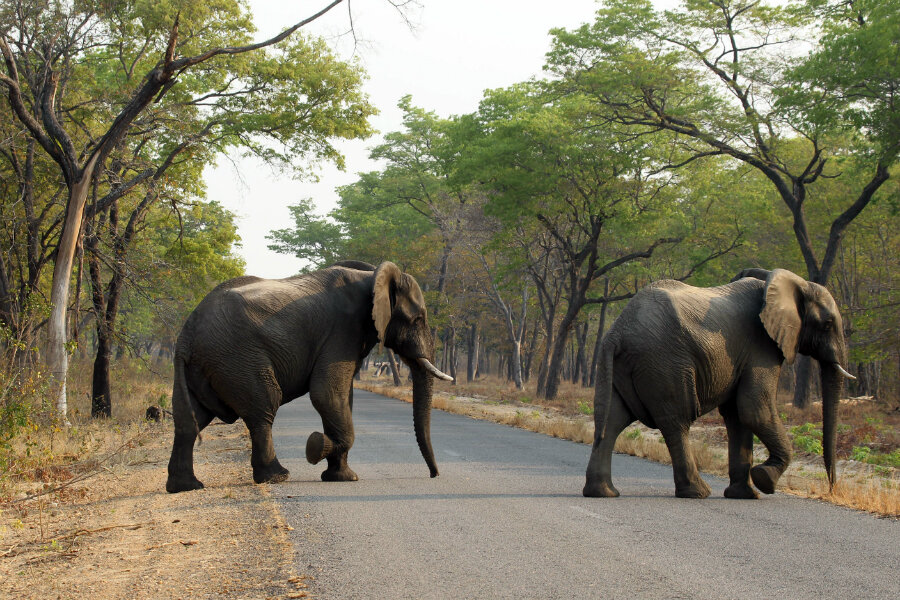Africa's elephants: why it could take 100 years to recover from poaching
Forest elephants have seen a 65 percent population decline between 2002 and 2013 and now, because of low reproductive rates, it could take the species nearly a century for its population to recover from the effects of increased poaching over the past few decades, according to a study published Wednesday in the Journal of Applied Ecology.
The research was a combined effort between Wildlife Conservation Society (WCS), the Cornell Lab of Ornithology’s Elephant Listening Project, Colorado State University, and Save the Elephants.
Despite the grim outlook, however, conservation organizations and governments alike are working on ways to effectively ban poaching and curb the global ivory trade to protect this beloved animal.
"This work provides another critical piece of understanding regarding the dire conservation status of forest elephants," the study's lead author Andrea Turkalo, WCS Associate Conservation Scientist, said in a press release.
The team collected data on the forest elephant birth and death rate from nearly daily visits between 1990 and 2013 to the Dzanga Bai in Central African Republic, a mineral rich area of the forest that attracts elephants, and used that data to calculate the approximate rebound rate.
There are two species of elephants that live across the African continent, the forest elephant and the savannah elephant. Dr. Turkalo found forest elephants, which make up about a quarter of Africa's elephant population, face a distinct disadvantage because they primarily feed off the limited reserves of the forest canopy. As a result, the study says, the forest elephant reaches sexual maturity even later and produces calves even further apart than its counterpart the savannah elephant.
"Female forest elephants in the Dzanga population typically breed for the first time after 23 years of age, a markedly late age of maturity relative to other mammals," Turkalo said in a press release. "In contrast, Savannah elephants typically begin breeding at age 12. In addition, breeding female forest elephants only produced a calf once every five or six years, relative to the three- to four-year interval found for Savannah elephants."
This is a problem not just for the elephant population, but for the forest as a whole since elephants fill a key ecological niche. Colloquially known as the "mega-gardeners of the forest," the elephant's enormous appetite and migration patterns allows the species to distribute more than 1 ton of dung-fertilizer weekly as well as spreading the seeds for many trees and plants native to the forest.
Although the study tracks a rise in poaching since 2002, in recent years world leaders, as well as conservation organizations, have made a concerted effort to curb poaching and the ivory trade.
China, where the world's largest ivory market has been flourishing for years, has seen a nearly 50 percent drop in the past two years, according a report published last December by Save The Elephants. Former NBA star Yao Ming was instrumental in reducing consumption of shark fin soup in China and is now working on changing Chinese attitudes toward elephant ivory, reports The Christian Science Monitor.
Like shark fin soup, owning ivory was becoming a way for China’s growing middle class to showcase their wealth. And also like shark fin soup, Yao is working to change public perceptions about ivory.
“To win this battle against poaching, we need multiple approaches,” Yao told The Monitor in 2012 while visiting the David Sheldrick Wildlife Trust in Kenya. “What I am trying to do is to raise people’s awareness, to show them the reality of the ivory business. When the killing of elephants happens 10,000 miles away from you, it’s easy to hide yourself from that truth. If we show people, they will stop buying ivory. Then the elephants will stop dying.”
The United States also tightened its ivory trade laws when the US Fish and Wildlife Service announced new regulations that limit sales to pre-existing manufactured items with 200 grams of ivory or less, and restricts hunters from bringing home more than two ivory trophies a year.
"Up until now, ivory markets in the US have pretty much had free run," Jeff Flocken, the North American regional director for the International Fund for Animal Welfare, told The Christian Science Monitor shortly after the ruling in June. "It was very hard to prosecute people for selling ivory because the exceptions and loopholes were so large. The rule that came out and was finalized yesterday really takes a hard look at what is legal and what isn't, and the as the US government said, it's a near ban."
International Union for the Conservation of Nature's World Conservation Congress will meet from Sept. 1-10 in Hawaii and one of the topics up for debate is a push to close domestic ivory markets entirely. Additionally, the Convention on International Trade in Endangered Species meets in Johannesburg in late September as well.
"Legislation regarding ivory trade must consider the collateral effects on forest elephants and the difficulties of protecting them," George Wittemyer, chair of the Scientific Board of Save the Elephants and a professor in Wildlife Conservation at Colorado State University, said in a press release. "Trade in ivory in one nation can influence the pressures on elephants in other nations."






